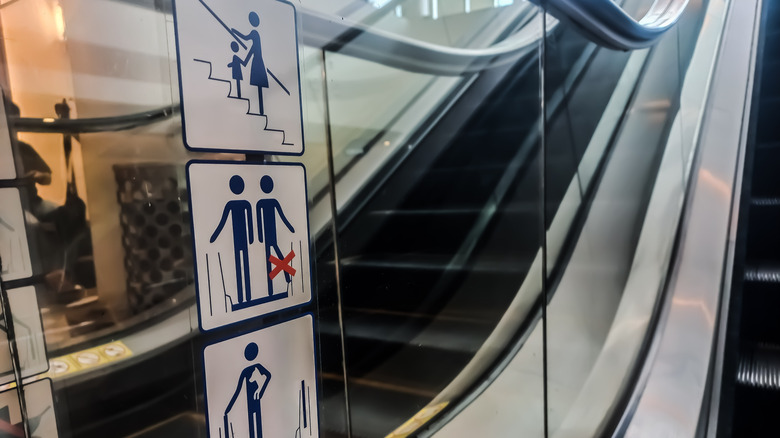What Are The Brushes On The Sides Of Escalators For?
With the fast-paced nature of our modern world, many of us have to rush from one place to another, trying to keep up with the demands of life. And while flying cars already exist, we still have to wait a bit longer until the average person can get one. In the meantime, most of us can enjoy the little joys that make traveling easier, like escalators. While the first escalator has been around for more than a century, there are a growing number of places that rely on escalators, like theme parks in high places or even the sides of mountains. In many ways, this opens up the world for people who struggle with mobility, like the elderly or disabled.
Most of us have the oddly specific experience of riding an escalator and running the sides of our shoes on the brushes. But, what exactly are they actually used for? Well, KONE shares that it's actually made to prevent shoes, clothes, and other objects from being trapped on the side of the elevator, which can help prevent accidents. The escalator manufacturer also cautions that you should avoid using them to clean your shoes, since it might lead to stuck shoelaces.
Safely tips for riding an escalator
Apart from the brushes, escalators have other safety-related features. All escalators have grooved metal steps, which can help prevent slipping. They also typically have yellow borders that signal where it is safe to stand, reducing the risk of losing one's balance. Escalators also have comb plates at the beginning and end that help ease the transition from the regular, flat ground to the moving steps, as well as keeping shoes, clothing, and random things that may fall out of bags and pockets from getting into the inside of the machine. As for your hands, escalators are also equipped with handrails that protect your fingers from being hurt.
But, knock on wood, if an accident does happen, you can usually spot a big red button that is designed to stop the entire escalator in an emergency. This is usually placed in both the top and bottom parts of the escalators. Unlike in elevators, wherein you can get trapped during a power failure, the built-in braking system of an escalator means it just turns into stairs. That said, when it comes to safety, it is often a combination of good infrastructure and more mindful habits. There are many things that may be out of your control when riding escalators in public places, such as how much maintenance the facility performs. However, there are still some good escalator riding habits that can prevent a lot of escalator-related problems.
Tips for staying safe on escalators
To start with, KONE mentions that it's best to both hold the handrail and try to stand in the middle of the step. While there are a lot of things you need to do on your phone while you're traveling, it's best not to use your mobile phone, especially when stepping on and off. Should you be moving with children or pets, it's also your responsibility to either carry them or guide them through it. And of course, if you are moving with any bulky items, like strollers or large luggage, you may want to just wait for the next elevator instead. This should also be your first option if you are wearing very loose clothing (or, for whatever reason, need to be barefoot), which might snag on the escalator sides. If you're the parent of young children or a traveler with large luggage, bear in mind that Google Maps lets you check wheelchair-accessible routes.
If there are no functioning elevators and you have no choice but to use the escalator, you can opt to adopt practical escalator habits. For example, when you're heading downwards, place large items that have a tendency to roll behind you. With this, you're sure that it won't unceremoniously fall into the person in front of you. In the same vein, it's best to keep luggage on the step in front of you when going upwards, so you can keep your eye on it.


